Fill up your Super Soaker and break out your lightsaber—there are zombies afoot! This band of kids is ready for anything—are you?
What Is Zombie Kidz Evolution?
Zombie Kidz Evolution is a legacy-style cooperative game for 2 to 4 players, ages 7 and up, and takes about 15 minutes to play… if you can limit yourself to one session, that is. It retails for $22.99 and is available in stores now or online. Although the game does feature zombies, they’re fairly cartoonish and the game isn’t scary—even my own kids, who normally refuse to play anything with zombies, didn’t mind fighting zombies in this one. Zombie Kidz Evolution was published by Scorpion Masque, and is distributed in the USA by Iello.
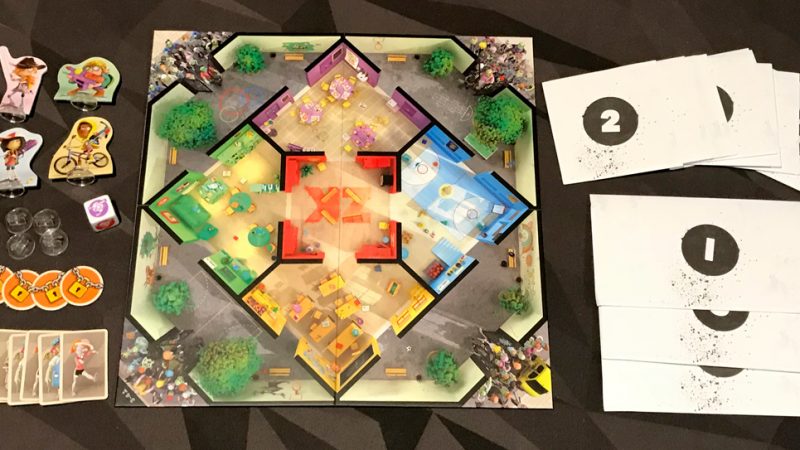
Zombie Kidz Evolution Components—Spoiler-Free Version
Here’s what comes in the box:
- Game board
- 4 Character standees
- 8 plastic stands
- Zombie die
- 4 Lock tokens
- 8 Zombie tokens
- 13 envelopes
Zombie Kidz Evolution is a legacy-style game, which means that things change as you play the game. In particular, you get to open up the envelopes as you progress through the game, which then changes the gameplay in various ways. I’ll keep spoilers about what’s in the envelopes on a separate page, though I may make some broad references without specifics.
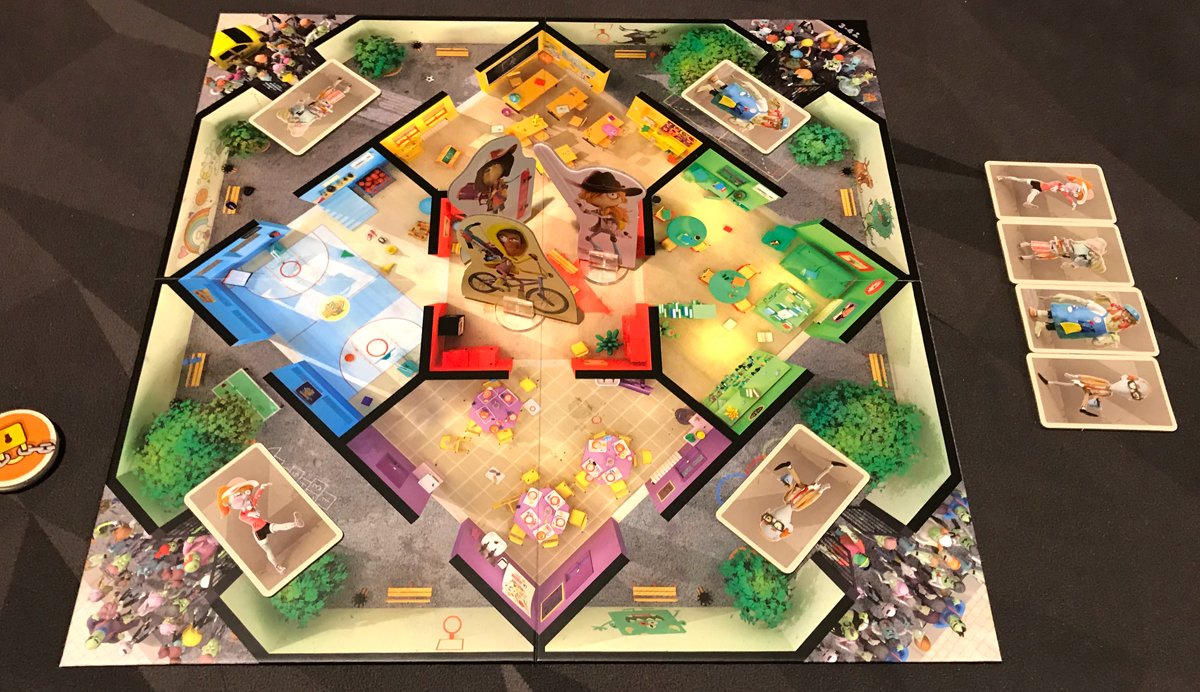
The board shows a bird’s-eye view of a school, with various interconnected classrooms and four exterior yards with gates. There’s a daytime side and a night-time side: the night-time side is used for 2 players, and includes extra doorways between the outer ring of rooms. The board has a lot of fun details that make the rooms distinct—there’s a gym, a library, a classroom, a lunchroom, and a central area with lockers.

The character standees show the four kids that you can choose from, and they’ve all got a lot of personality. I like that there’s a mix of genders and ethnicities, and each kid has their own weapon of choice (though, admittedly, it’s not clear how much damage a squirt gun or foam balls would actually do to a zombie).
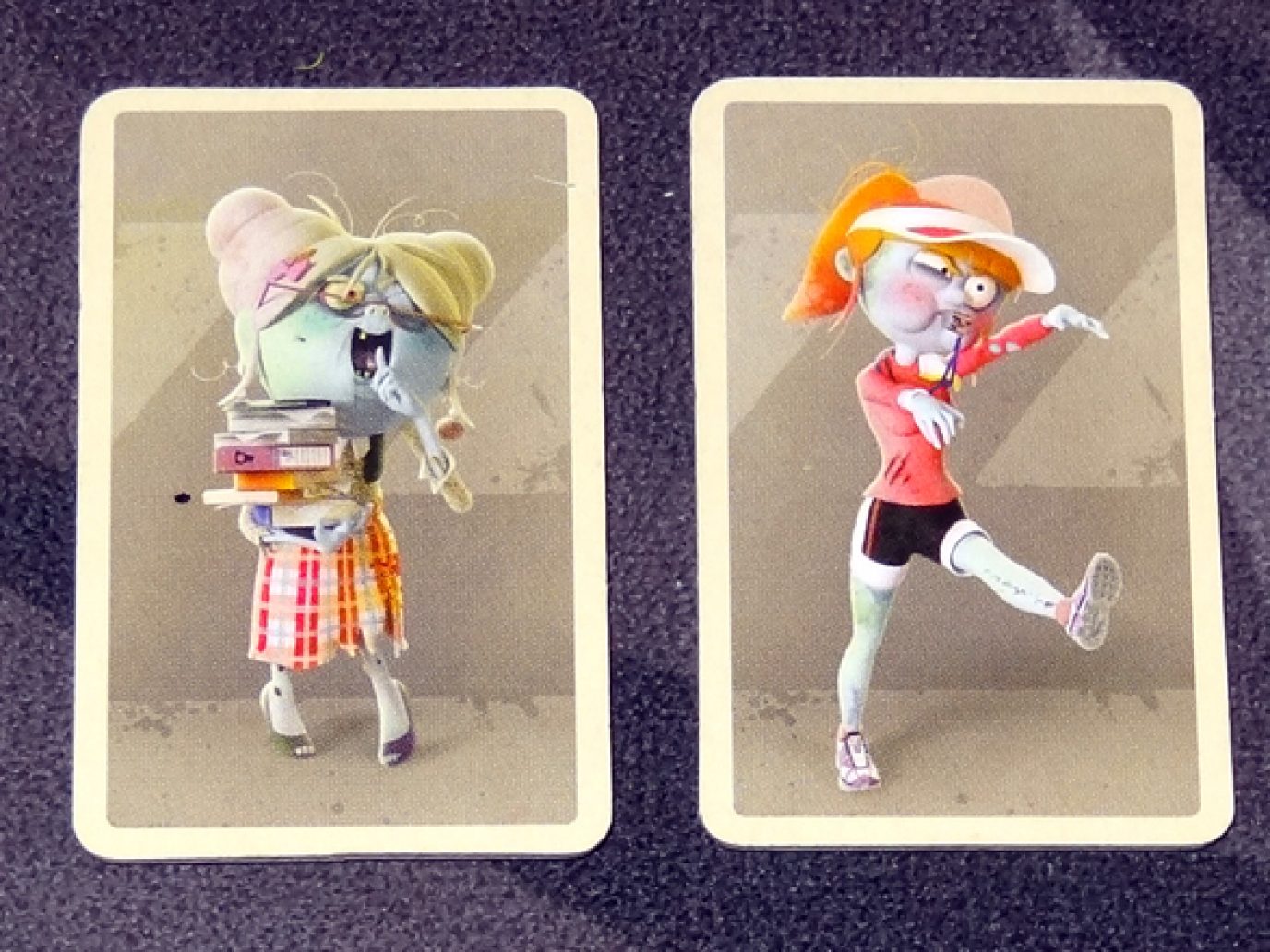
There are four zombies (two of each): a teacher (or principal?), a librarian, a gym teacher, and a custodian. Clearly, the staff wasn’t ready when the zombie apocalypse hit, but they still seem to be following their old routines. As I said, the zombies are more cute than scary, kind of like muppet zombies, and there isn’t any gore or anything depicted. These are small cardboard tiles, and they’re just placed flat on the board, without stands.
The die is six-sided, with a zombie icon in the five different colors matching the rooms and one blank side. The icon is the same on each side, so red-green color-blind players may need some assistance telling those apart, and I found that the yellow-on-white can be a little harder to see depending on the lighting. The icons are printed on the die, but not engraved.
The lock tokens are also just punch-out cardboard tiles, showing some chains with a big padlock on it.
The envelopes… well, we’ll get to those later, but there are 13 total, mostly square but a few larger rectangular envelopes. And for some reason, there are 8 plastic stands, but only 4 character standees. Hmmm, curious…
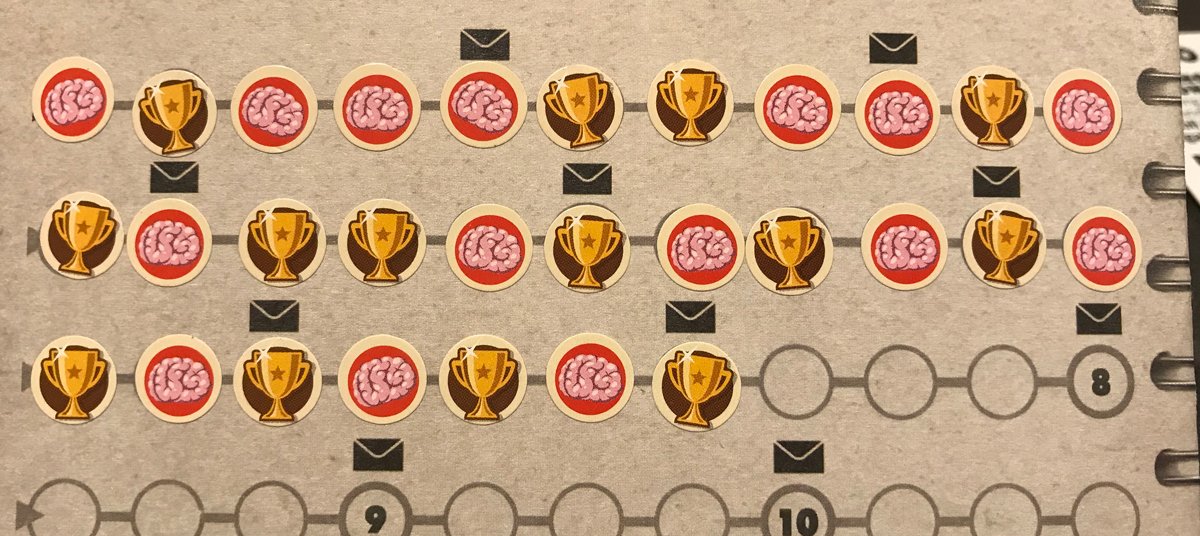
The rulebook isn’t pictured in my components photo, though it’s also an important piece of the game. The outside is made to look like a spiral-bound notebook with lots of stickers on the cover, so it’s only appropriate that you’ll be putting stickers on the back cover, too. There’s a progress chart on the back that you’ll soon be filling up with brain and (you hope) trophy stickers. Inside the rulebook, you’ll also notice a few sections that have large blank areas: some in “Advanced Rules” and some in “Missions.” More about those later.
 Zombie Kidz Evolution is GeekDad Approved!
Zombie Kidz Evolution is GeekDad Approved!
How to Play Zombie Kidz Evolution
You can download a copy of the rulebook here.
The Goal
The goal of each session is to lock all four gates before you’re overwhelmed by zombies. But there’s also a larger goal of completing missions and making progress on the progress chart so that you can open up those envelopes!
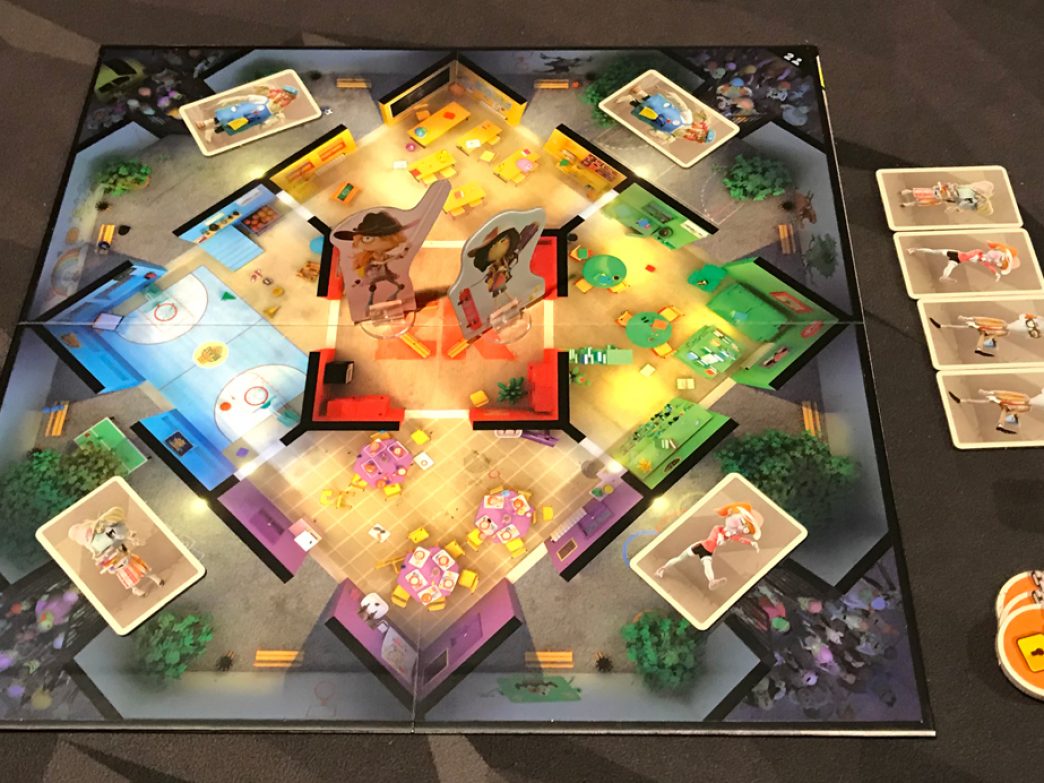
Setup
Set up the board, using the night side for 2 players and the day side for 3 or 4 players. Each player chooses a kid and places it in the red room in the center. Randomly place one zombie in each courtyard in the corners of the board. Place the rest of the zombies in a row next to the board, and keep the die and the lock tokens handy.
Gameplay
On your turn, you first place a zombie: you roll the die and place the next zombie from the line into the corresponding room. If you roll a blank, lucky you: no zombies this turn.

Then, you may move your character 1 space through a doorway (or stay put). You may then kill any zombies in the room you’re in, placing them at the end of the row next to the board.
Note that if 3 or more zombies are in a room, then kids cannot enter that room. If you’re in a room when the third zombie is added, then you must immediately move to an adjacent room.
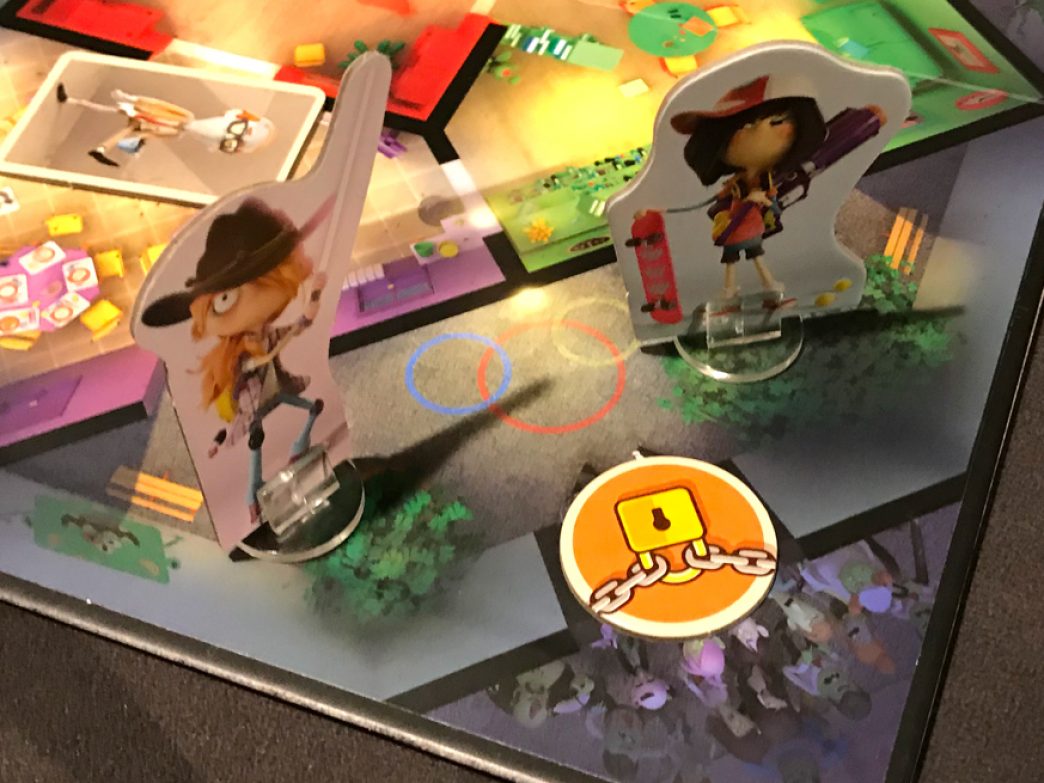
Finally, if you are in a courtyard and there is another kid there with you, then you place a lock token on the gate.
Game End
You win if you lock all 4 gates. You lose if you need to place a zombie on the board, and there are no more in the line.
Pretty simple, right? But wait, there’s more!
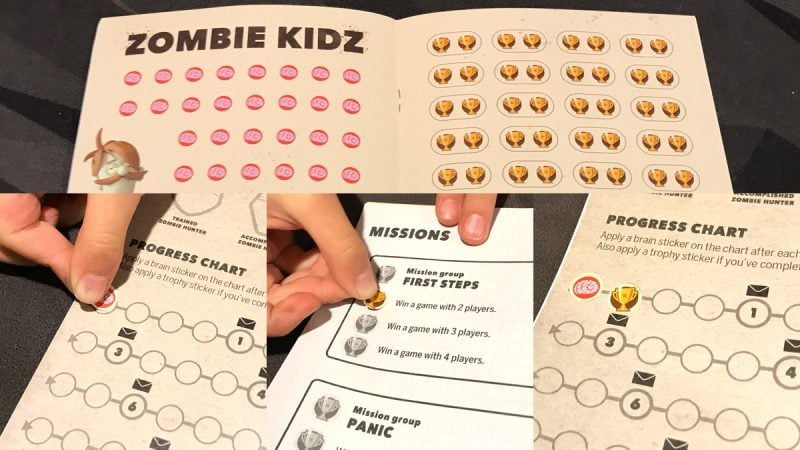
Making Progress
Every time you play the game, win or lose, you get to add a brain sticker to the progress chart on the back of the rulebook. In addition, there are missions to complete, things like winning a game at various player counts, eliminating all of the zombies after you’ve locked all 4 gates, or winning the game while using only 6 zombies total. You’re allowed to complete one mission per play, but you could earn a second trophy sticker if you complete a mission group. (Each mission group has 3 missions.)
If you place a sticker on a space with an envelope icon above it, then you get to open that numbered envelope! As you make progress, you’ll discover new bonuses inside the envelopes that change the game and help it, you know, evolve.

Why You Should Play Zombie Kidz Evolution—Spoiler-Free Version
Okay, I’ll stop here and tell you a bit about Zombie Kidz Evolution without spoilers, though you if you want a closer look at what else is included in those envelopes, feel free to forge ahead! I’ve put spoilers on page 2.
I’ve played (okay, technically I’ve started) a few legacy-style games, like Risk: Legacy and Gloomhaven, and it’s taken me a little bit to get used to the idea of putting stickers or writing on game components, let alone tearing things up or throwing them away. Kids, on the other hand, don’t tend to have those same barriers: after all, they’re likely to treat every game like a legacy game, right? So the idea of creating a legacy game for kids is brilliant–it’s a game that comes with its own sticker chart, and you know how motivating those are.
The base gameplay I’ve outlined above is fairly simple, and is in fact based on an older title from 2013 called Zombie Kidz, which did not have the evolving elements to it, though it did have some rules variants to adjust the difficulty level. I would say that if the game were limited to the core rules, I’d probably have gotten tired of it pretty quickly–there’s a lot of luck involved, and once you get several zombies piled into the same room, then there’s only so much time before you run out of options because there’s no way to deal with them.
But getting to mark your progress as you play and work toward opening those envelopes adds a bit of excitement even when you’re playing by the core rules. And then when you open the envelopes? The game gets more interesting, and begins to present more of a challenge, too. It feels like you end up with more strategic choices, though the luck of the die roll still presents a good bit of random chance.
Although I wasn’t always happy with the order in which the bonus material shows up, I was pleased with the content itself, and I think it adds a good bit of variety that kept the game fresh through the time it took us to open up all the envelopes. (For us, it took about 26 plays to get through everything, but the number of plays will vary depending on how well you manage to complete missions each time you play.) Even after the last envelope is opened, though, there’s some incentive to continue playing. We haven’t hit the point yet where we’re tired of playing, and in many cases, we played several sessions in a row when we were pushing for the next envelope.
I have some more specific thoughts in the spoiler section, but I do think part of the joy of the game (as with many legacy games) is the discovery. Unlike some legacy games, Zombie Kidz Evolution progresses the same way for everyone—the envelopes are always opened in the same order, though you’re welcome to complete the missions in whatever order you choose. If you’re convinced enough by what you’ve read so far, I’d suggest leaving it at that and checking it out if it sounds intriguing. If you really want to know what exactly is included in those other envelopes, forge ahead here!
Click here to see all our tabletop game reviews.
![]() To subscribe to GeekDad’s tabletop gaming coverage, please copy this link and add it to your RSS reader.
To subscribe to GeekDad’s tabletop gaming coverage, please copy this link and add it to your RSS reader.
Disclosure: GeekDad received a copy of this game for review purposes.






